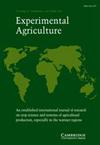控释尿素在不影响共生固氮的情况下提高大豆产量
IF 1.9
4区 农林科学
Q1 Agricultural and Biological Sciences
引用次数: 3
摘要
在巴西,高产大豆[Glycine Max (L). Merrill] -玉米(Zea mays L.)双熟制可能是氮(N)有限的,额外施氮可能是有益的。大豆早期施氮降低了共生固氮(SNF)效率和(或)建立。避免SNF损害的一种替代方法是在开始荚果(R3)和灌种(R5)阶段之间施用氮肥,通过使用控释肥料。本研究采用随机完全区组设计,在热带和亚热带条件下,采用6个处理、4个重复,以50 kg ha - 1施用氮肥,分别作为普通尿素(CU)或控释尿素(CRU),不同滞后期(30天、60天或两种滞后期的1:1混合),直至氮素开始释放。CU在大豆出苗后(VE)或初豆荚(R3)施用,CRU仅在VE施用。利用15N同位素标记的尿素,分析了大豆氮素来源(肥料、土壤或SNF)和SNF参数。平均而言,在R3期施用CRU - 30天、CRU - 1:1混合(30 + 60天)和CU可使籽粒产量比对照提高9.2% (354 kg ha - 1)。所有施肥处理的氮素提取量均接近35 kg N ha - 1,氮素回收率高达68%。SNF不受CU和CRU的影响,占总氮吸收的71% (220 kg N ha - 1)。在本试验条件下,施用50 kg N ha - 1作为CRU可有效满足大豆后期(R3期)的氮素需求,在不破坏高产环境下SNF过程的情况下提高产量。本文章由计算机程序翻译,如有差异,请以英文原文为准。
Controlled release urea increases soybean yield without compromising symbiotic nitrogen fixation
Summary In Brazil, high-yield soybean [Glycine Max (L). Merrill] – corn (Zea mays L.) double cropping system might be nitrogen (N)-limited and additional N fertilization can be beneficial. Early application of N in soybean reduces the symbiotic N fixation (SNF) efficiency and/or establishment. One alternative to avoid SNF impairment is to apply N between the beginning pod (R3) and seed-fill (R5) stages through the use of controlled release fertilizers. In this study, N was applied at 50 kg ha−1 as common urea (CU) or controlled release urea (CRU) with different lag periods until N release starts (30 days, 60 days, or 1:1 mix of both lag times) in a randomized complete blocks design with six treatments and four replicates under tropical and subtropical conditions. CU was applied after soybean emergence (VE) or at the beginning pod (R3), and CRU only at VE. Using urea labeled with 15N isotope, we analyzed the N source used by soybean (fertilizer, soil, or SNF) and SNF parameters. On average, CRU – 30 days, CRU – 1:1 mix (30 + 60 days) and CU applied at the R3 stage increased grain yield by 9.2% (354 kg ha−1) compared to the control. N derived from all fertilizer treatment were almost 35 kg N ha−1, a high N recovery efficiency of 68%. The SNF was not impaired by CU and CRU and accounted for 71% (220 kg N ha−1) of total N uptake. In the conditions of the experiments, fertilization of 50 kg N ha−1 as CRU was shown to be effective to supply N in late soybean demand (R3 stage), increasing yield without damaging the SNF process in high-yield environments.
求助全文
通过发布文献求助,成功后即可免费获取论文全文。
去求助
来源期刊

Experimental Agriculture
农林科学-农艺学
CiteScore
2.50
自引率
6.20%
发文量
29
审稿时长
24 months
期刊介绍:
With a focus on the tropical and sub-tropical regions of the world, Experimental Agriculture publishes the results of original research on field, plantation and herbage crops grown for food or feed, or for industrial purposes, and on farming systems, including livestock and people. It reports experimental work designed to explain how crops respond to the environment in biological and physical terms, and on the social and economic issues that may influence the uptake of the results of research by policy makers and farmers, including the role of institutions and partnerships in delivering impact. The journal also publishes accounts and critical discussions of new quantitative and qualitative methods in agricultural and ecosystems research, and of contemporary issues arising in countries where agricultural production needs to develop rapidly. There is a regular book review section and occasional, often invited, reviews of research.
 求助内容:
求助内容: 应助结果提醒方式:
应助结果提醒方式:


